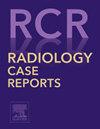继发于免疫检查点抑制剂的动脉前缺血性视神经病变1例报告
Q4 Medicine
引用次数: 0
摘要
缺血性视神经病变(ION)是由于视神经供血不足而发生的,其中前部缺血性视神经病变(AION)通常与巨细胞动脉炎(GCA)相关。用于癌症治疗的免疫检查点抑制剂(ICI)与神经-眼免疫相关不良事件(irAEs)有关,尽管ICI治疗导致的动脉前缺血性视神经病变(AAION)的发展非常罕见。本病例报告描述了一位77岁男性转移性肾细胞癌患者,接受ICI治疗后出现双侧视力丧失并被诊断为AAION。MRI结果支持GCA-AAION伴眼眶受累,患者使用皮质类固醇后立即出现部分改善,尽管颞动脉活检不确定。该病例强调了提高临床对ici相关眼部并发症的认识的必要性,并强调了诊断和管理ici引起的AAION的挑战,强调了进一步研究治疗策略以减轻不可逆视力丧失的必要性。本文章由计算机程序翻译,如有差异,请以英文原文为准。
Arteritic anterior ischemic optic neuropathy secondary to immune checkpoint inhibitors: A case report
Ischemic optic neuropathy (ION) occurs due to insufficient blood supply to the optic nerve, with anterior ischemic optic neuropathy (AION) commonly associated with giant cell arteritis (GCA). Immune checkpoint inhibitors (ICIs), used in cancer therapy, have been linked to neuro-ophthalmic immune-related adverse events (irAEs), though the development of arteritic anterior ischemic optic neuropathy (AAION) due to ICI therapy is exceptionally rare. This case report describes a 77-year-old male with metastatic renal cell carcinoma on ICI therapy who presented with bilateral vision loss and was diagnosed with AAION. MRI findings supported GCA-AAION with orbital involvement, and the patient showed immediate but partial improvement with corticosteroids, despite a nonconfirmatory temporal artery biopsy. This case underscores the need for heightened clinical awareness of ICI-associated ocular complications and highlights the challenges in diagnosing and managing ICI-induced AAION, emphasizing the need for further research into treatment strategies to mitigate irreversible vision loss.
求助全文
通过发布文献求助,成功后即可免费获取论文全文。
去求助
来源期刊

Radiology Case Reports
Medicine-Radiology, Nuclear Medicine and Imaging
CiteScore
1.10
自引率
0.00%
发文量
1074
审稿时长
30 days
期刊介绍:
The content of this journal is exclusively case reports that feature diagnostic imaging. Categories in which case reports can be placed include the musculoskeletal system, spine, central nervous system, head and neck, cardiovascular, chest, gastrointestinal, genitourinary, multisystem, pediatric, emergency, women''s imaging, oncologic, normal variants, medical devices, foreign bodies, interventional radiology, nuclear medicine, molecular imaging, ultrasonography, imaging artifacts, forensic, anthropological, and medical-legal. Articles must be well-documented and include a review of the appropriate literature.
 求助内容:
求助内容: 应助结果提醒方式:
应助结果提醒方式:


